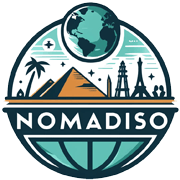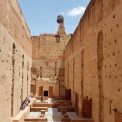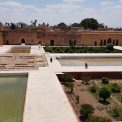1000 km, 4 cities, and countless experiences. Beachy Agadir – bustling Marrakesh – cinematic Casablanca – maze-like Fez. That’s how our adventurous road trip through Morocco looked like. If you want to experience authentic Morocco, make sure not to miss the royal cities of Marrakesh and Fez. If you want to see the Sahara, you have to detour from our route to the eastern borders to the town of Merzouga. If you still have time after all of that, we recommend the blue town of Chefchaouen.
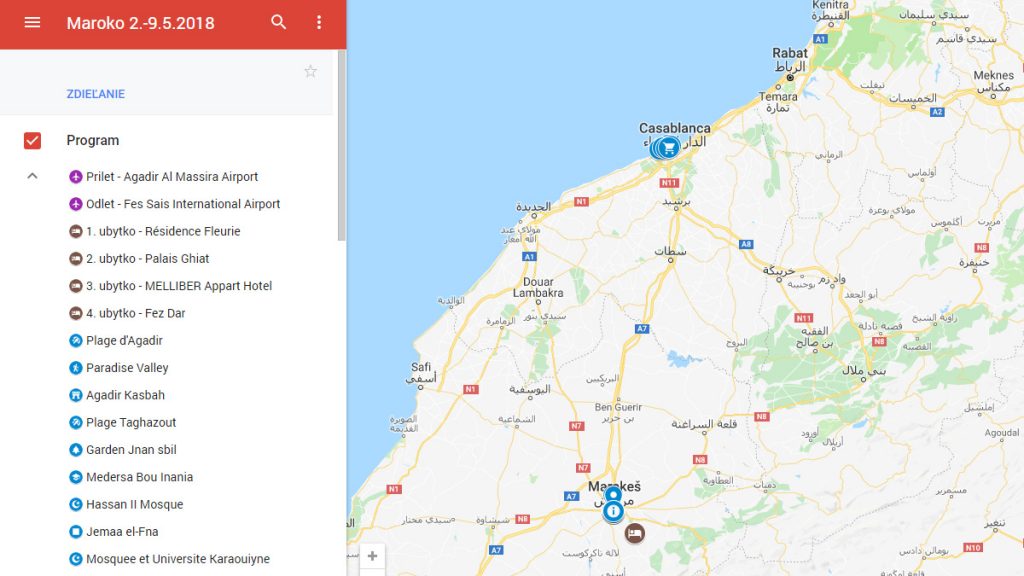 Detailed map of our points of interest[/caption>
Detailed map of our points of interest[/caption>
Practical Information
- You only need a passport to enter Morocco; visas are not required.
- For car rentals, you need a VISA or Mastercard credit card (debit cards or others are not accepted).
- A free city guide tour in English (“za tringelt”) can be taken in Marrakesh out of these 4 cities.
- Moroccans do not consume alcohol; you can only get alcohol in specialized stores like Uniprix in Agadir or selected Carrefour supermarkets.
- There are toll fees on highways (e.g., Agadir – Marrakesh 66 MAD).
- Marrakesh has chaotic traffic; we recommend only for very skilled drivers.
- Locals in Fez might offer to guide you and then demand payment (often just leading you through a maze of streets and not getting you to the destination); they typically ask for 10-20 MAD, so it’s better not to reveal your destination even if you are lost.
- It is recommended to wash the car before returning it (we paid 40 MAD). Otherwise, they might charge you for cleaning.
- Throughout Morocco, non-Muslims are not allowed to enter mosques (an exception is the Hassan II Mosque in Casablanca).
- While “medina” means “city” in Arabic, in Morocco, it refers to the old Arabic center of each city.
- The basic rule for shopping is always to haggle.
Beachy Agadir and Surroundings (2 days)
Upon arrival in Agadir, we pick up the car from Thrifty. Lately, we book the car through Ryanair Car Hire, which works best along with extra insurance from Axy (also on their website). Since we will return the car at Fez airport, there is an additional fee of 80€. It’s about 25 km from the airport to the center of Agadir. We selected accommodation in Agadir through booking.com
1. Paradise Valley

Paradise Valley – we can only agree with the literal translation – a paradise valley. It’s about an hour’s drive from Agadir (40km) and you’ll already be treated to beautiful views of the landscape on the way there.
TIP: The end of the road leads through narrow paths alongside the river, where picnic spots are set right in the shallow river, and you can stop for a quick coffee or mint tea.
At the beginning of the valley, there is a free parking lot. The path continues along a hiking trail. Wear sturdy shoes (at least sneakers). After about 20 minutes, you’ll reach the promised paradise. The rocky gorge narrows and forms a beautiful natural pool. You can just lay back on the rocks and relax. GPS route
2. Plage d’Agadir

Plage d’Agadir – the main beach in Agadir with brown sand and a gentle entry into the Atlantic Ocean. Along the promenade, there are plenty of restaurants and bars where we tasted traditional Moroccan tajine (pronounced ta-zeen). Agadir itself didn’t particularly charm us, so we don’t recommend spending too many days here unnecessarily.
TIP: If you don’t know where to go for good food, look for restaurants where locals eat
3. Agadir Kasbah Fortress

Fortress Agadir Kasbah – an ancient military fortress from 1540 that was nearly destroyed after a devastating earthquake in 1960. Today, it serves as a tourist attraction with a panoramic view of the Agadir beach. On the hill below the fortress, there is a huge Arabic inscription “Allah – Nation – King,” made of white stones, which shines over the city in the evening.
4. Plage Taghazout

Plage Taghazout – an open sandy beach north of Agadir, worth visiting when the wind is calm. Construction of luxury apartments and hotels is taking place near the beach, so it doesn’t look the most beautiful at the moment.
TIP: Nearby is the restaurant no.1 according to Tripadvisor – Babakoul.
5. Jardin d’Olhao

Jardin d’Olhao – a relaxation garden by the Mohammed V Mosque with traditional Berber architecture (Berbers were the original inhabitants of North Africa). The garden also houses the Memory Agadir Museum, where interesting photographs of the city from before and after the earthquake are exhibited. Next to the park is the Mohammed V Mosque.TIP: In Agadir, we discovered an excellent liquor store, Uniprix – inside it looks like a market, but they have a good selection of wine, beer, and spirits.
Wild Marrakesh (2 days)
Around noon, we move from Agadir to Marrakesh. Transportation in Marrakesh is legendary. Two lanes and in them go three cars, a bicycle, a horse, and a motorcycle.
TIP: A good parking lot in the center is near the Koutoubia Mosque (see our map) – if you let yourself be guided through the madness, a clever local boy asked us for 30 MAD for his services. In this case, we were truly grateful to him.
1. Evening square Jemaa el-Fna

the heart of Marrakesh full of street food, artists, and coffee shops. Be prepared for persistent persuasion to visit individual stalls. We tried brochette – meat on a stick, merguez – small sausages, harira – chickpea soup. For a quick refreshment, buy orange juice for 4 MAD.
TIP: Bring your own cutlery or eat with your hands, as cutlery only gets “cleaned” with a napkin behind your back. Also, it’s safer to ask for juice in a plastic cup (for an extra 1 MAD). You will appreciate the disinfectant gel there.
TIP: The best view of the entire Jemaa el-Fna square is from the terrace of Café de France hotel.
2. Free city guide
Free city guide – a “free” tour of the old city with an English-speaking guide, starting every day at 10:10 in front of the Argana restaurant (Jemaa el-Fna square). If you catch a guide like we did, be prepared for a 5-hour tour where we visited:
- Mešita Koutoubia – the largest and most beautiful mosque in Marrakesh
- Saadian Tombs (10 MAD) – tombs of the Saadian dynasty, which ruled Morocco from 1554 to 1659.
- El Badi Palace (10 MAD) – a magnificent ruin of a palace from 1593, the courtyard once had several pools. A folklore festival is often held here.
- Bahia Palace (10 MAD) – the grand vizier Ba Ahmed built the palace for his wife Bahia, who bore him his first son. The most photographed spot on Instagram.
- Old Medina Souks – markets everywhere, we recommend the spice alley marked on our map.
3. Botanical Garden
Botanical Garden Jardin Majorelle – we didn’t have a chance to visit it, but if you have enough time, it’s reportedly worth it. Entrance fee 70 MAD.
Casablanca Movie Tour (1 day)
The transfer from Marrakech to Casablanca takes about 3 hours with a break. Casablanca is the largest city in Morocco. However, it is not as touristy as Marrakesh or Fez. It has more of an atmosphere from the 80s and apart from the old town, it lacks beauty.
1. Hassan II Mosque

Hassan II Mosque – a magnificent and the largest mosque in Morocco, the only one that is open to non-Muslims. The minaret of the mosque, at a height of 210 meters, is the tallest in the world. It’s worth seeing it in the evening when it’s illuminated. Entrance fee 120 MAD.
2. Plage Aïn Diab

Plage Aïn Diab – one of the main beaches in Casablanca, a long sandy beach with a gradual entry into the ocean. It is located next to the main city promenade with restaurants. During our visit, it was windier and cooler, so we used the beach for a long walk.
3. Rick’s Café
Rick’s Café – If you are a fan of the classic movie Casablanca, don’t miss this bar. Great live jazz music, magical atmosphere, cigars, and excellent cocktails. If you know the movie, you might be aware that none of it was actually filmed in Casablanca. However, this place has not lost its charm, and we gladly let ourselves be “deceived” by the illusion of the atmosphere of this legendary film.
TIP: For a larger grocery shopping, we recommend the largest Carrefour Gourmet
Labyrinthine Fez (2 days)
Fez is the oldest of the four royal cities of Morocco and also the best-preserved medieval Arab city in the world dating back to 789. The atmosphere is incredible, even better than in Marrakesh. You will wander through a maze of streets full of local products from all over the world, live chickens, rabbits, barrels full of snails, and cow heads.
Get ready for an unbelievable labyrinth where you can get lost within minutes without GPS. Beware, ubiquitous “guides” are lurking everywhere, trying to lure you into local shops, and once you engage, you won’t shake them off easily, and they will demand at least 10 – 20 MAD (the key is not to reveal your destination).
The city of Fez consists of 3 main parts:
- Fes el-Bali – the oldest part of the city (medina) accessible through 11 exterior gates. Its narrow streets could be compared to Jerusalem.
- Fes el-Jdid – a quarter built as an extension of Fes el-Bali, housing the royal palace and the Jewish quarter.
- Ville Nouvelle – a modern district built during the French colonial era, with hotels, banks, and shopping centers.
TIP: If you want to stay in the old city, we recommend accommodation at Fez Dar – excellent location near the main gate Bab Boujloud, right next to a parking lot and such a friendly staff we have not experienced for a long time (the term dar denotes a traditional family home in Morocco)
TIP: Withdraw money from an ATM at the airport, there it was fee-free. For example, an ATM in Fez near Bab Boujloud gate charged an extra 20 MAD.
1. Medina Fes el-Bali
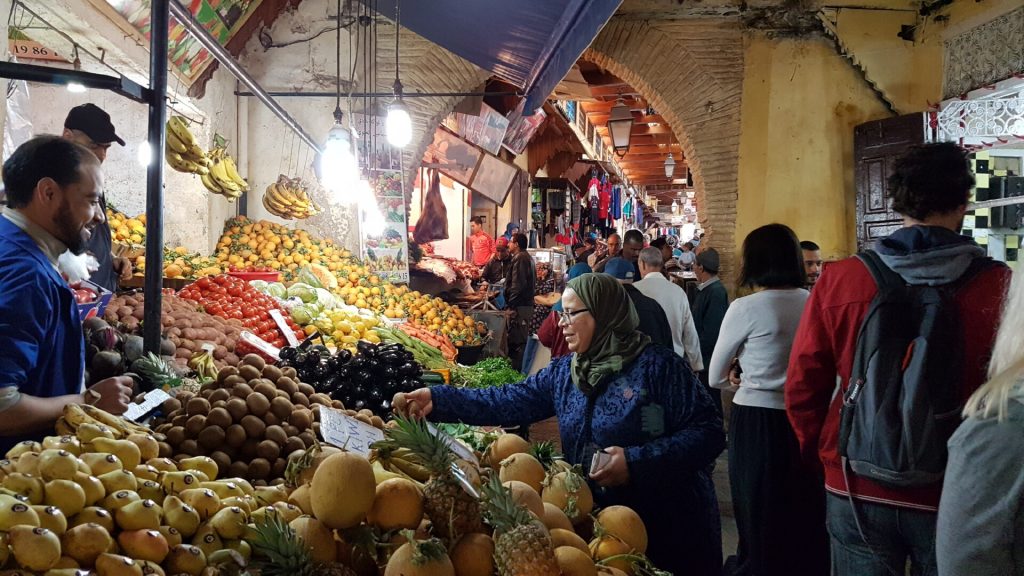
Medina Fes el-Bali – the old city of Fez, on the UNESCO list since 1981.
2. Bab Boujloud
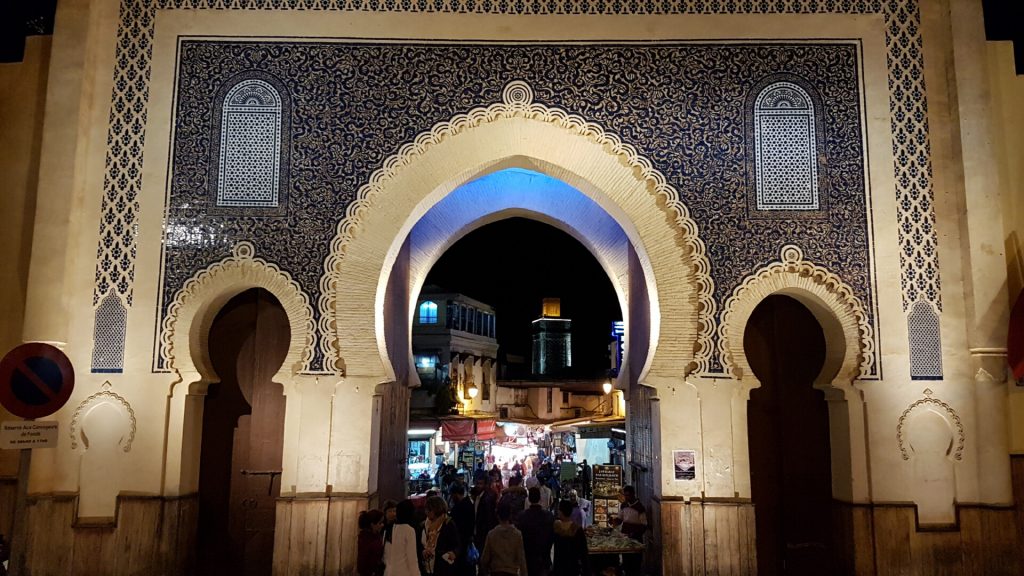
Bab Boujloud – one of the main enchanting gates to the medina, covered with blue tiles on the outside and green on the inside.
TIP: Near the gate, there are cafés with views over the whole of Fez
3. Medersa Bou Inania
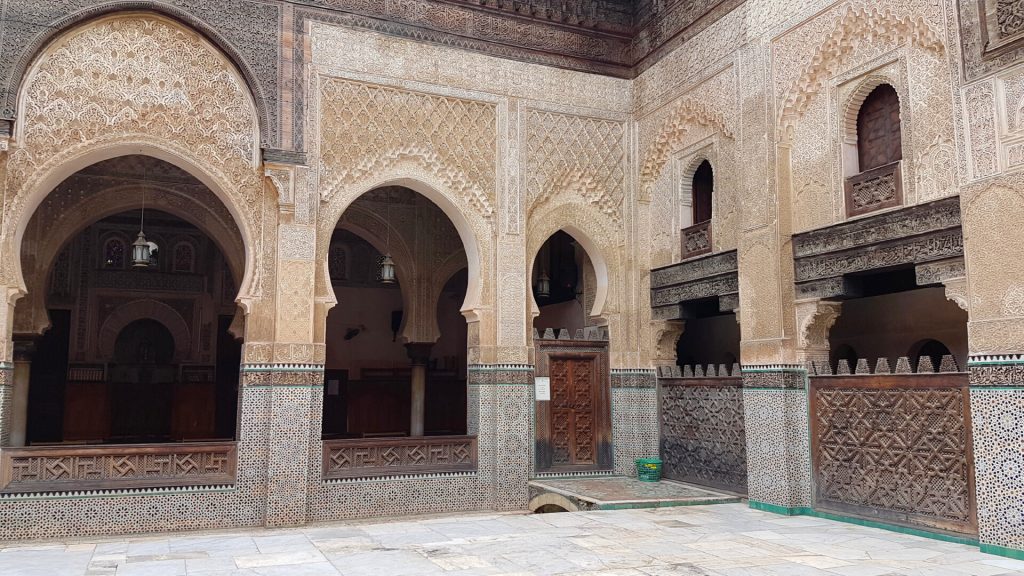
Medersa Bou Inania – originally a religious school from the 14th century, which is now used as a prayer room. Admission 20 MAD.
4. Tanneries
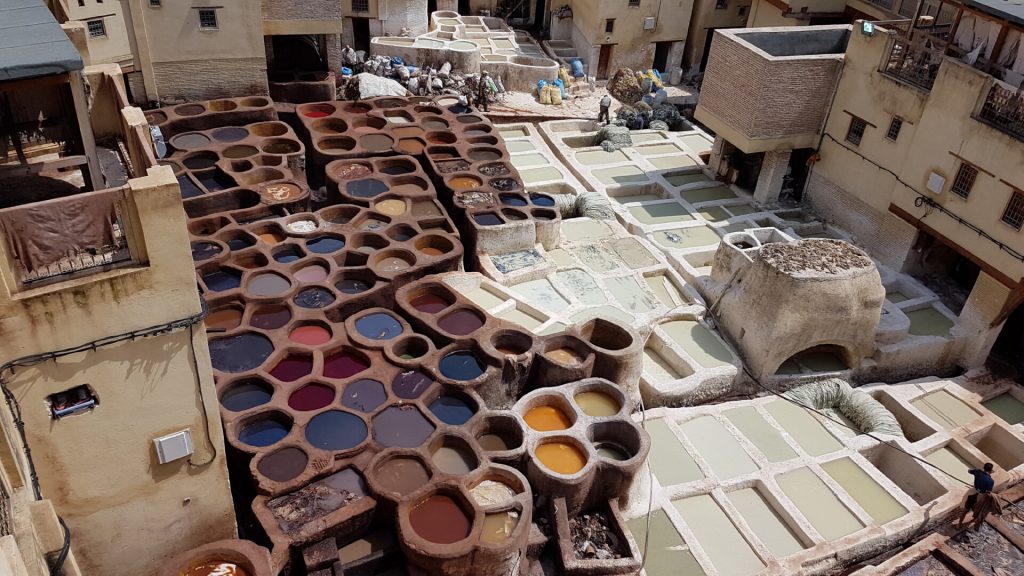
Tanneries – local tanneries, which are one of the biggest attractions. This occupation is usually passed down from father to son, which is why there are entire families dedicated to dyeing. All colors are natural – blue comes from indigo, yellow from saffron, red from poppy flowers, and green from herbs. The tanneries are practically invisible from the street, so you have to find a suitable vantage point. The view of the tanneries from the roofs of buildings – countless large vats made of clay, where the hides are immersed (often up to the waist of the men working there) is an unforgettable experience. Be prepared for a strong odor, as the processing involves cow urine and pigeon droppings. However, it is definitely worth it.TIP: We can recommend the viewpoint from Tannery Sidi Moussa, which was free of charge.
5. Nejjarine Fondouk
Nejjarine Fondouk – a wooden museum where you will find an extensive collection of wooden items used for centuries in Fes households. Admission 20 MAD.
6. University of Al-Karaouine
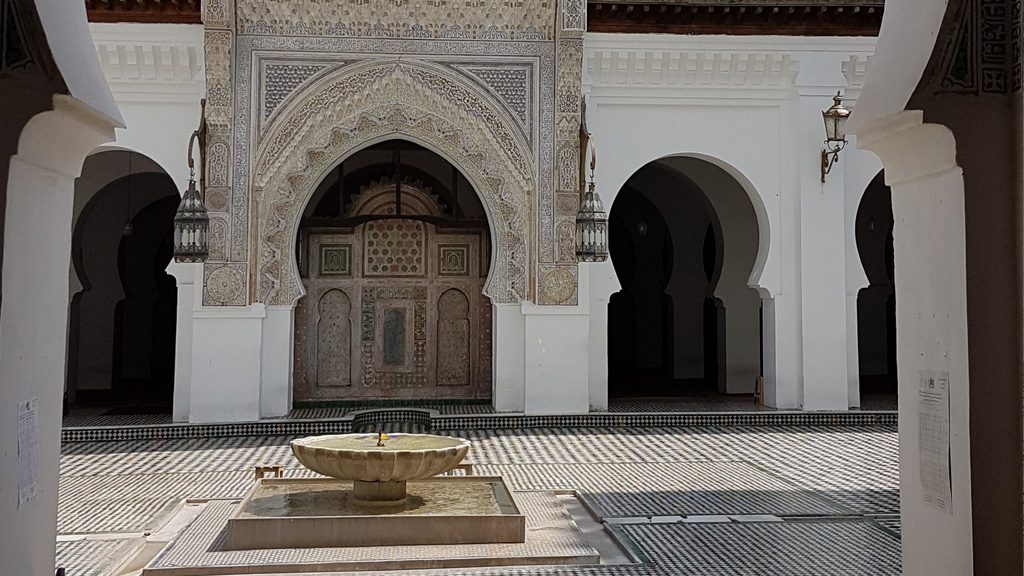
University of Al-Karaouine – the oldest continuously operating university in the world founded in 859. The mosque is accessible only to Muslims, so you can at least peek through the gate into the main courtyard.
7. Jnan Sbil Garden

Jnan Sbil Garden – a beautiful well-maintained garden located between the medinas of Fes el-Bali and Fes el-Jdid. If you’ve had enough of the narrow streets of the old city, we recommend this garden; it’s an oasis of peace. An interesting feature is the noria wheel in the park, which was used in the past to irrigate soil away from water sources.
